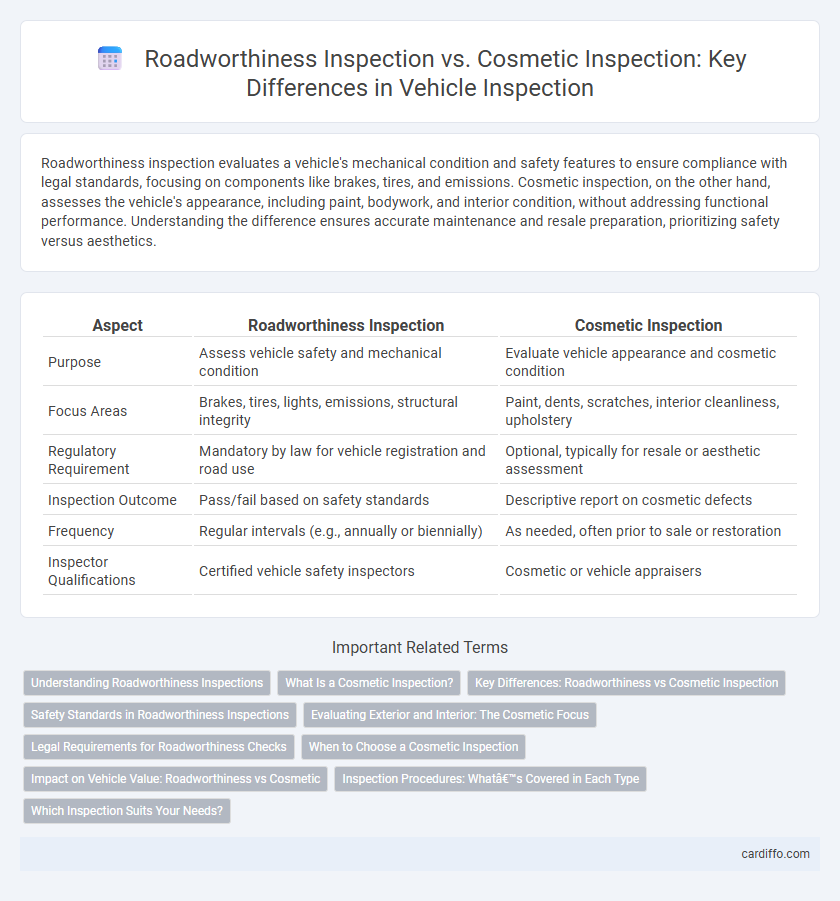Roadworthiness inspection evaluates a vehicle's mechanical condition and safety features to ensure compliance with legal standards, focusing on components like brakes, tires, and emissions. Cosmetic inspection, on the other hand, assesses the vehicle's appearance, including paint, bodywork, and interior condition, without addressing functional performance. Understanding the difference ensures accurate maintenance and resale preparation, prioritizing safety versus aesthetics.
Table of Comparison
| Aspect | Roadworthiness Inspection | Cosmetic Inspection |
|---|---|---|
| Purpose | Assess vehicle safety and mechanical condition | Evaluate vehicle appearance and cosmetic condition |
| Focus Areas | Brakes, tires, lights, emissions, structural integrity | Paint, dents, scratches, interior cleanliness, upholstery |
| Regulatory Requirement | Mandatory by law for vehicle registration and road use | Optional, typically for resale or aesthetic assessment |
| Inspection Outcome | Pass/fail based on safety standards | Descriptive report on cosmetic defects |
| Frequency | Regular intervals (e.g., annually or biennially) | As needed, often prior to sale or restoration |
| Inspector Qualifications | Certified vehicle safety inspectors | Cosmetic or vehicle appraisers |
Understanding Roadworthiness Inspections
Roadworthiness inspections are critical evaluations designed to ensure a vehicle meets safety and environmental standards, focusing on key components such as brakes, tires, lights, and emissions systems. Unlike cosmetic inspections, which assess aesthetic elements like paint, dents, and interior condition, roadworthiness inspections prioritize functionality and compliance with legal safety regulations to guarantee safe operation on public roads. Regular roadworthiness testing is essential for preventing accidents and maintaining vehicles' operational integrity.
What Is a Cosmetic Inspection?
A cosmetic inspection evaluates a vehicle's exterior and interior appearance, focusing on paint condition, body damage, upholstery, and overall cleanliness rather than mechanical functionality. Unlike roadworthiness inspections, which ensure safety and compliance with legal standards, cosmetic inspections target aesthetic aspects to assess value or potential resale appeal. This type of inspection helps identify issues like scratches, dents, rust, and interior wear that do not affect vehicle operation but influence buyer perception.
Key Differences: Roadworthiness vs Cosmetic Inspection
Roadworthiness inspection evaluates a vehicle's mechanical condition and safety features to ensure compliance with legal standards for safe operation on public roads. Cosmetic inspection focuses solely on the vehicle's appearance, checking for dents, scratches, and paint quality without assessing functional or safety aspects. Key differences lie in the scope: roadworthiness impacts legal acceptability and safety, whereas cosmetic inspection influences aesthetic condition without regulatory implications.
Safety Standards in Roadworthiness Inspections
Roadworthiness inspections prioritize compliance with safety standards by thoroughly assessing critical vehicle components such as brakes, tires, lights, steering, and suspension systems to ensure safe operation on public roads. Unlike cosmetic inspections, which focus on the vehicle's appearance, roadworthiness inspections target functional integrity and mechanical reliability to prevent accidents and ensure occupant safety. These assessments are mandated by regulatory bodies to maintain a minimum safety threshold, reducing risks associated with vehicle malfunctions.
Evaluating Exterior and Interior: The Cosmetic Focus
Roadworthiness inspections evaluate the vehicle's safety-critical components such as brakes, lights, and structural integrity, ensuring compliance with legal standards. Cosmetic inspections concentrate on assessing the vehicle's exterior and interior aesthetics, including paint condition, upholstery wear, and surface damage. The cosmetic focus helps determine resale value and overall appearance without addressing safety or mechanical functionality.
Legal Requirements for Roadworthiness Checks
Roadworthiness inspections are mandated by law to ensure vehicles meet safety, emissions, and operational standards required for public roads, involving thorough checks of brakes, lights, tires, and structural integrity. Cosmetic inspections focus on vehicle appearance and do not satisfy legal requirements for roadworthiness certifications or influence vehicle registration validity. Failure to pass a roadworthiness inspection can result in fines, vehicle impoundment, or suspension of registration, emphasizing the mandatory nature of these checks for compliance with traffic regulations.
When to Choose a Cosmetic Inspection
Choose a cosmetic inspection when vehicle appearance and minor surface damages are the primary concerns rather than structural integrity or safety compliance. This type of inspection is ideal for pre-sale evaluations, warranty claims, or routine maintenance where aesthetics influence resale value. Cosmetic inspections do not assess mechanical systems, unlike roadworthiness inspections required for legal and safety certification.
Impact on Vehicle Value: Roadworthiness vs Cosmetic
Roadworthiness inspections focus on critical safety and mechanical conditions, directly affecting a vehicle's legal operation and long-term reliability, thus having a significant impact on vehicle value. Cosmetic inspections assess aesthetic aspects like paint, dents, and interior wear, influencing the vehicle's market appeal but not its fundamental functionality. Consequently, roadworthiness issues tend to lower vehicle value more drastically than cosmetic imperfections due to their implications for safety and operability.
Inspection Procedures: What’s Covered in Each Type
Roadworthiness inspection primarily covers critical safety components such as brakes, tires, lights, steering, and exhaust systems to ensure a vehicle meets legal safety and emissions standards. Cosmetic inspection focuses on the vehicle's aesthetic condition, assessing paint quality, body damage, interior wear, and minor dents or scratches without evaluating mechanical functionality. Understanding the detailed scope of each inspection helps prioritize repairs for safety compliance versus appearance enhancement.
Which Inspection Suits Your Needs?
Roadworthiness inspection evaluates a vehicle's mechanical condition, safety features, and compliance with legal standards, ensuring it is safe and fit for driving. Cosmetic inspection focuses on the vehicle's appearance, checking for dents, scratches, paint quality, and interior condition, primarily serving buyers interested in aesthetics. Choose roadworthiness inspection for safety assurance and legal compliance, and opt for cosmetic inspection if visual condition outweighs mechanical concerns.
Roadworthiness inspection vs cosmetic inspection Infographic

 cardiffo.com
cardiffo.com